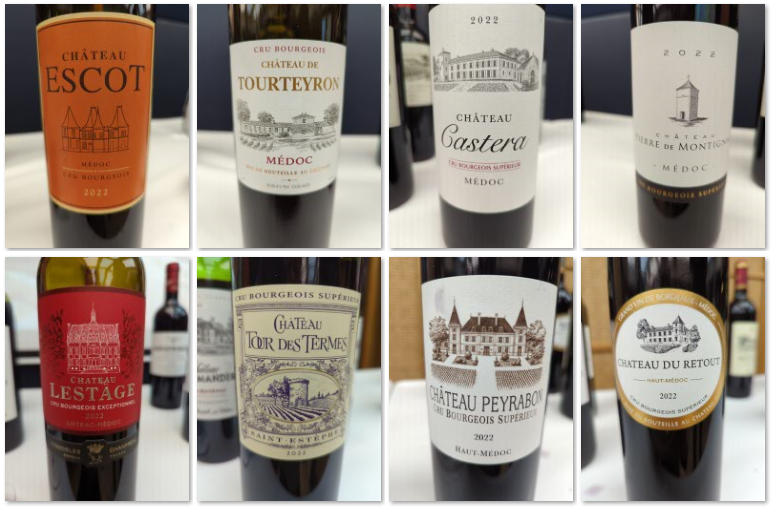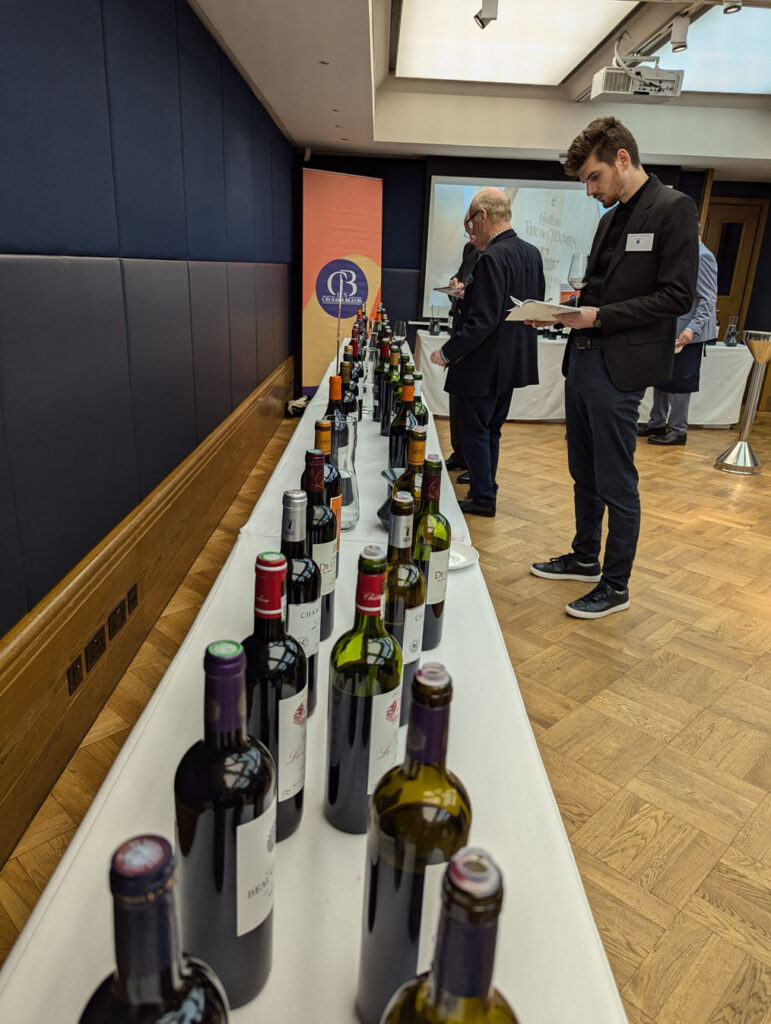
In mid-November 2024, I attended a Cru Bourgeois du Médoc tasting event in London, featuring a selection of 64 wines from the 2022 vintage. Roughly 60% of the wines presented were seeking representation, making it an interesting event for industry professionals and wine merchants on the lookout for new additions.
I’ve put together a short overview article for newcomers to Cru Bourgeois du Médoc. It covers the essentials, including the region’s location, the classification system, production numbers and the typical flavour profile of these wines. It also outlines the three-tiered Cru Bourgeois classification system that recognises quality among non-classified Médoc estates.
The majority of the wines at the tasting were typical of the Cru Bourgeois du Médoc style. They were a deep red in colour, with an aromatic profile with vibrant red fruit notes and medium to strong tannins. Here are the wines that stood out to me, primarily because, as it turned out, they were quite atypical of the majority:

Château Escot, a Cru Bourgeois Supérieur with an ABV of 13.5%, is a blend of 55% Cabernet Sauvignon and 45% Merlot. This wine stands out with intense cassis and plum flavours, complemented by a warm spice profile of cloves. Its abundant fruitiness balances the strong tannins, making them less pronounced and more integrated. Château Escot is currently seeking distribution, with an expected price range of £15 to £20.
Château de Tourteyron, a 13% ABV Cru Bourgeois, brings together 50% Cabernet Sauvignon, 48% Merlot and a touch of 2% Petit Verdot. This wine captivated me with its alluring aroma of violets and vibrant red fruit, followed by a rich cherry flavour and a deep, layered middle palate. There’s a subtle spice in the mix, balanced with notably soft tannins that lend this wine a powerful yet delicate character. It was one of my standout favourites from the tasting. Currently seeking distribution, Château de Tourteyron is expected to be between £15 and £20.
Château Castera, a Cru Bourgeois Supérieur at 14% ABV, is a blend of 65% Merlot, 25% Cabernet Sauvignon, 5% Cabernet Franc, and 5% Petit Verdot. This wine impresses with its aromatic profile, offering inviting notes of cherry and plum. The tannins are well-integrated, enhancing the wine’s structure without overpowering the taste. Château Castera also has excellent length on the palate, leaving a lasting impression. Currently seeking distribution, it is expected to sell at around £19.

Château Pierre de Montignac, a 13.5% ABV Cru Bourgeois Supérieur, is a blend of 50% Merlot, 45% Cabernet Sauvignon and 5% Petit Verdot. It offers a compelling aroma and a deeply fruit-forward character, reminiscent of Primitivo or Zinfandel, with a rich, concentrated profile. Full-bodied and boasting soft to medium tannins, it delivers a bold yet approachable experience. Excellent. This wine stood out as one of my favourites from the tasting. Currently seeking distribution with an anticipated range of £12 to £18.
Château Lestage, a Cru Bourgeois Exceptionnel with an ABV of 14.5%, is a blend of 65% Merlot, 31% Cabernet Sauvignon, 3% Cabernet Franc and 1% Petit Verdot. This wine stood out being unlike anything else in the room, with an intriguing oaky aroma and a smoky flavour profile. The medium tannins provide structure without overpowering its character. Excellent. Interestingly, if I had tasted it blind, I might have mistaken it for a Carmenere due to its distinct smoky notes. Currently seeking distribution, Château Lestage is expected to sell between £15 and £20.
Château Tour des Termes, a 14% ABV Cru Bourgeois Supérieur, is made from a blend of 60% Merlot, 30% Cabernet Sauvignon, 5% Cabernet Franc, and 5% Petit Verdot. This wine is beautifully aromatic, with prominent strawberry notes on the nose, followed by ripe raspberry and strawberry flavours in the taste. The medium to high tannins are seamlessly integrated, blending harmoniously with the deep fruit flavours so that they go almost unnoticed. Currently seeking distribution, Château Tour des Termes is expected to sell in the £25 to £30 range.
Château Peyrabon, a 14.5% ABV Cru Bourgeois Supérieur, is a blend of 55% Cabernet Sauvignon, 34% Merlot, 8% Cabernet Franc and 3% Petit Verdot. This wine opens with a subtle smoky aroma, followed by deep fruit notes layered with a touch of chocolate on the finish. The tannins are relatively soft, making it smooth and approachable, with a satisfying long finish. Excellent. Château Peyrabon is available from Justerini & Brooks and Cambridge Wine & Spirits.
Château du Retout, a 14% ABV Cru Bourgeois Supérieur, is a blend of 57% Cabernet Sauvignon, 23% Merlot and 10% Petit Verdot. This wine offers inviting notes of blackberry and prune, with a gentle, smooth character that sets it apart as a more approachable example. The tannins are low to medium, enhancing its smoothness, while the finish reveals hints of fig and sweet spices. Excellent. Available from Wine at Home and Château du Retout.
In summary, the tasting showcased a range of relatively inexpensive wines, for Bordeaux, with a very noticeable consistency in style/quality across the majority of the wines, with only slight variations between them. That said, I was pleased to find several standout examples above, wines that broke from the typical mould and offered something extra memorable and distinctive.













